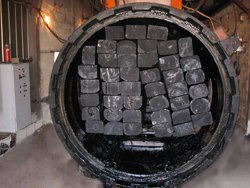 |
Cross ties are maintained in adverse conditions therefore are exposed to biological destruction. For increase in service life they are subject to obligatory protective processing. The indicators characterizing reliability of protective processing (together with indicators characterizing quality of carrying out process of impregnation) are absorption and depth of penetration of a protective means. Absorption the antiseptics in wood unit of volume represent weight absorbed. Depth of penetration is understood as the minimum value of depth of impregnation. Value of these indicators is individual for each breed. Ability of wood to become impregnated (permeability) on section of a tree trunk strongly changes. The peripheral part of a trunk called by a sapwood, becomes impregnated rather well. According to GOST 20022.0-93 this part of a trunk forms easy impregnated a zone (LPZ). The central part of a trunk called by a kernel (ripe wood), becomes impregnated much worse, and it forms hard impregnated a zone (TPZ). In cross ties there can be LPZ and TPZ, the Requirement to quality of impregnation of these zones a miscellaneous. Since the main volume of cross ties occupies TPZ, only the high pressure way can provide demanded quality and depth of impregnation. Other ways don't allow to provide demanded reliability of protection of wood therefore aren't admissible for impregnation of cross ties.
According to GOST of 20022.2-80 conditions of service of wood till speed of a unpreserved share on 18 classes. Service conditions of cross ties correspond to the 13th class. For this class of conditions of service GOST 20022.0-93 defines the next ways of High pressure impregnation: VDV (vacuum pressure vacuum); DV (pressure vacuum); DDV (pressure-pressure-vacuum).
Our enterprise makes impregnation according to the requirement of standards, technological instructions in accordance with GOST 20022.0 pressure — pressure — vacuum (DDV)
Way DDV apply to impregnation of cross ties, translated and bridge bars, details of support of power lines and communication columns.
Quality of impregnation of wood is characterized by the general absorption of a protective tool by depth of impregnation.
Products arriving in impregnation pealed with complete removal of a bass. Machining of products to be made before impregnation.
Before impregnation humidity of wood should be no more than 25 %.
Products before impregnation are sorted on sortiment and breeds of wood with equally set general absorption of a protective tool and depth of impregnation and taking into account impregnability of wood in accordance with GOST 20022.2.
Products become impregnated laid in packages so that the protective tool had access to all their surfaces.
In a cold season, at temperature below or equal 0°Ñ, products before impregnation warm up a hot protective tool. The temperature of a protective tool should be lower than flash temperature on 5°Ñ.
Impregnation to be made to protective equipment by coal oil in accordance with GOST 2770-74.
Preliminary air pressure makes from 0,2 (2) to 0,4 MPas (4 kgs/cm2). Working liquid pressure for wood of coniferous breeds makes no more than 1,2 MPas (12 kgs/cm2), for wood of firm deciduous breeds — no more than 1,4 MPas (14 kgs/cm2).
Depth of final vacuum not less than 0,08 MPas (0,8 kgs/cm2).
The temperature protective means during the period of liquid pressure in limits 90°Ñ and is lower than flash temperature on 5°Ñ.
The general absorption of a protective tool and depth of impregnation corresponds to GOST 20022.0 requirements.
<< Back